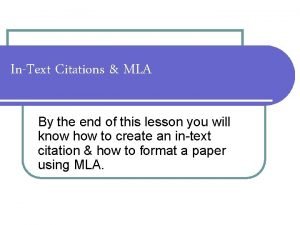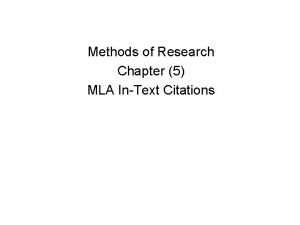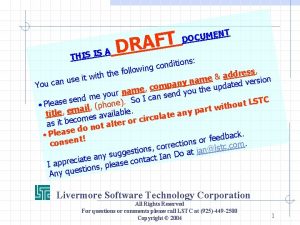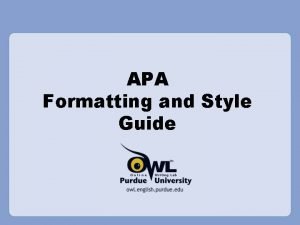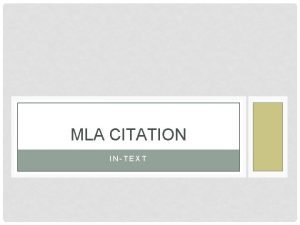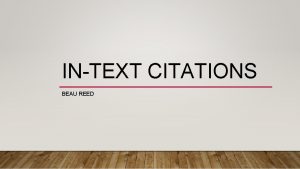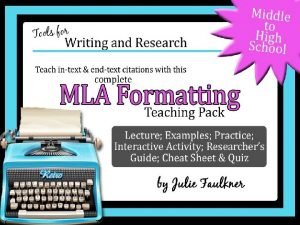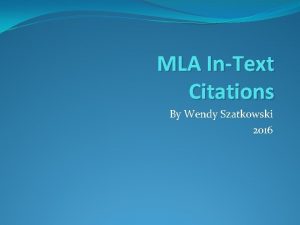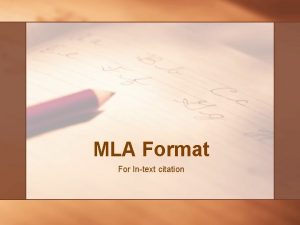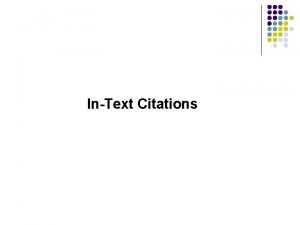MLA CITATIONS COMPONENTS 2 Major Components Intext citations






- Slides: 6

MLA CITATIONS: COMPONENTS 2 Major Components: § In-text citations (parenthetical citations) § End-text citations (references, works cited)

IN-TEXT CITATIONS (PARENTHETICAL) In-Text Components: § Author Last Name (if available) § Page Number (if available) § If neither is available, need to identify by shortened title (“ 5 ways”). Rules for Use: § Period goes on the outside of the parentheses: (Banks 5). § Parentheses go outside the quotation marks: Back in the day narratives “show black people working diligently to resolve… tensions and debates” (Banks 5). § If author’s name (or title) is used in sentence, no need to repeat it in the parenthetical citation: Banks explains that the back in the day narratives “show black people working diligently to resolve… tensions and debates” (5).

END-TEXT CITATIONS (REFERENCES, WORKS CITED) Works Cited Components: § Author name § Title of piece of writing (italicized if book, quotes if essay/short piece) § Title of larger collection/volume (if applicable) (italicized) § City of publication § Publishers § Year published § Medium (Print, Web, E-Book, Audio File, etc. ) Example: Banks, Adam. Digital Griots: African American Rhetoric in a Multimedia Age. Urbana: NCTE, 2011. Print. Sometimes also need: § Date accessed (if website) § Editor (if a collection)

WORKS CITED FORMATTING Always put Works Cited on a new page (Insert > Break > Page Break) “Works Cited” gets centered on page Entries in alphabetical order, according to the first letters of the entry (usually author last/first, or if no author, title of piece). Hanging indent: 0. 5” BOTTOM LINE: § Visit the Purdue OWL to help you figure this stuff out! Aside from the really basic stuff you need to keep in mind as you’re doing in-text citations, there’s no need to memorize this stuff.

FROM SHERMAN ALEXIE’S LITERACY NARRATIVE “I can remember picking up my father's books before I could read. The words themselves were mostly foreign, but I still remember the exact moment when I first understood, with a sudden clarity, the purpose of a paragraph. I didn't have the vocabulary to say "paragraph, " but I realized that a paragraph was a fence that held words. The words inside a paragraph worked together for a common purpose. They had some specific reason for being inside the same fence. This knowledge delighted me. I began to think of everything in terms of paragraphs. Our reservation was a small paragraph within the United States. My family's house was a paragraph, distinct from the other paragraphs of the Le. Brets to the north, the Fords to our south and the Tribal School to the west. Inside our house, each family member existed as a separate paragraph but still had genetics and common experiences to link us. Now, using this logic, I can see my changed family as an essay of seven paragraphs: mother, father, older brother, the deceased sister, my younger twin sisters and our adopted little brother. ”

PARAGRAPH CONSIDERATIONS SCOPE: How much is going on in the paragraph, how broad or narrow the idea is. FORECASTING: Introducing the mini-aims of your paragraph; points before particulars. INTERNAL COHESION: How each sentence connects to and builds on the one that came before it. CONNECTION TO PARAGRAPHS BEFORE/AFTER: How your essay builds momentum, often through the first and final sentence of each paragraph. CONNECTION TO OVERALL AIMS: How each paragraph supports the larger aims and vision of the paper, often through the final sentences of the paragraph.
